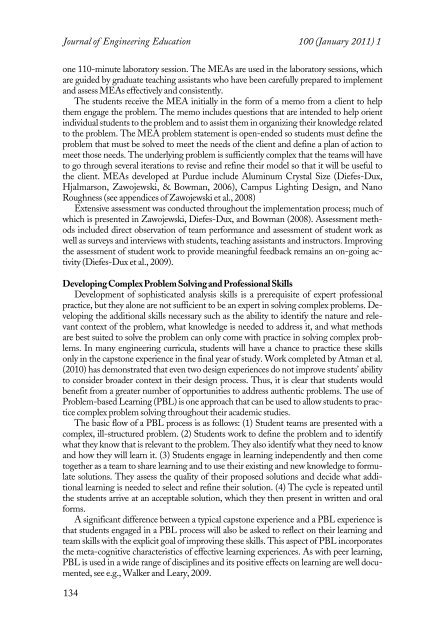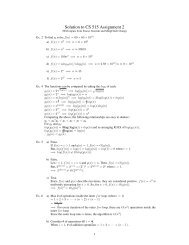Engineering Education and the Development of Expertise - Classes
Engineering Education and the Development of Expertise - Classes
Engineering Education and the Development of Expertise - Classes
You also want an ePaper? Increase the reach of your titles
YUMPU automatically turns print PDFs into web optimized ePapers that Google loves.
Journal <strong>of</strong> <strong>Engineering</strong> <strong>Education</strong> 100 (January 2011) 1<br />
one 110-minute laboratory session. The MEAs are used in <strong>the</strong> laboratory sessions, which<br />
are guided by graduate teaching assistants who have been carefully prepared to implement<br />
<strong>and</strong> assess MEAs effectively <strong>and</strong> consistently.<br />
The students receive <strong>the</strong> MEA initially in <strong>the</strong> form <strong>of</strong> a memo from a client to help<br />
<strong>the</strong>m engage <strong>the</strong> problem. The memo includes questions that are intended to help orient<br />
individual students to <strong>the</strong> problem <strong>and</strong> to assist <strong>the</strong>m in organizing <strong>the</strong>ir knowledge related<br />
to <strong>the</strong> problem. The MEA problem statement is open-ended so students must define <strong>the</strong><br />
problem that must be solved to meet <strong>the</strong> needs <strong>of</strong> <strong>the</strong> client <strong>and</strong> define a plan <strong>of</strong> action to<br />
meet those needs. The underlying problem is sufficiently complex that <strong>the</strong> teams will have<br />
to go through several iterations to revise <strong>and</strong> refine <strong>the</strong>ir model so that it will be useful to<br />
<strong>the</strong> client. MEAs developed at Purdue include Aluminum Crystal Size (Diefes-Dux,<br />
Hjalmarson, Zawojewski, & Bowman, 2006), Campus Lighting Design, <strong>and</strong> Nano<br />
Roughness (see appendices <strong>of</strong> Zawojewski et al., 2008)<br />
Extensive assessment was conducted throughout <strong>the</strong> implementation process; much <strong>of</strong><br />
which is presented in Zawojewski, Diefes-Dux, <strong>and</strong> Bowman (2008). Assessment methods<br />
included direct observation <strong>of</strong> team performance <strong>and</strong> assessment <strong>of</strong> student work as<br />
well as surveys <strong>and</strong> interviews with students, teaching assistants <strong>and</strong> instructors. Improving<br />
<strong>the</strong> assessment <strong>of</strong> student work to provide meaningful feedback remains an on-going activity<br />
(Diefes-Dux et al., 2009).<br />
Developing Complex Problem Solving <strong>and</strong> Pr<strong>of</strong>essional Skills<br />
<strong>Development</strong> <strong>of</strong> sophisticated analysis skills is a prerequisite <strong>of</strong> expert pr<strong>of</strong>essional<br />
practice, but <strong>the</strong>y alone are not sufficient to be an expert in solving complex problems. Developing<br />
<strong>the</strong> additional skills necessary such as <strong>the</strong> ability to identify <strong>the</strong> nature <strong>and</strong> relevant<br />
context <strong>of</strong> <strong>the</strong> problem, what knowledge is needed to address it, <strong>and</strong> what methods<br />
are best suited to solve <strong>the</strong> problem can only come with practice in solving complex problems.<br />
In many engineering curricula, students will have a chance to practice <strong>the</strong>se skills<br />
only in <strong>the</strong> capstone experience in <strong>the</strong> final year <strong>of</strong> study. Work completed by Atman et al.<br />
(2010) has demonstrated that even two design experiences do not improve students’ ability<br />
to consider broader context in <strong>the</strong>ir design process. Thus, it is clear that students would<br />
benefit from a greater number <strong>of</strong> opportunities to address au<strong>the</strong>ntic problems. The use <strong>of</strong><br />
Problem-based Learning (PBL) is one approach that can be used to allow students to practice<br />
complex problem solving throughout <strong>the</strong>ir academic studies.<br />
The basic flow <strong>of</strong> a PBL process is as follows: (1) Student teams are presented with a<br />
complex, ill-structured problem. (2) Students work to define <strong>the</strong> problem <strong>and</strong> to identify<br />
what <strong>the</strong>y know that is relevant to <strong>the</strong> problem. They also identify what <strong>the</strong>y need to know<br />
<strong>and</strong> how <strong>the</strong>y will learn it. (3) Students engage in learning independently <strong>and</strong> <strong>the</strong>n come<br />
toge<strong>the</strong>r as a team to share learning <strong>and</strong> to use <strong>the</strong>ir existing <strong>and</strong> new knowledge to formulate<br />
solutions. They assess <strong>the</strong> quality <strong>of</strong> <strong>the</strong>ir proposed solutions <strong>and</strong> decide what additional<br />
learning is needed to select <strong>and</strong> refine <strong>the</strong>ir solution. (4) The cycle is repeated until<br />
<strong>the</strong> students arrive at an acceptable solution, which <strong>the</strong>y <strong>the</strong>n present in written <strong>and</strong> oral<br />
forms.<br />
A significant difference between a typical capstone experience <strong>and</strong> a PBL experience is<br />
that students engaged in a PBL process will also be asked to reflect on <strong>the</strong>ir learning <strong>and</strong><br />
team skills with <strong>the</strong> explicit goal <strong>of</strong> improving <strong>the</strong>se skills. This aspect <strong>of</strong> PBL incorporates<br />
<strong>the</strong> meta-cognitive characteristics <strong>of</strong> effective learning experiences. As with peer learning,<br />
PBL is used in a wide range <strong>of</strong> disciplines <strong>and</strong> its positive effects on learning are well documented,<br />
see e.g., Walker <strong>and</strong> Leary, 2009.<br />
134
















